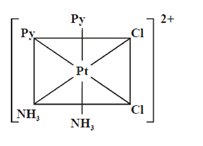IIT JAM Biology 2016
Previous Year Question Paper with Solution.
1. Pure lgG antibody was run on SDS-PAGE under reducing condition. How many bands would you see after staining with Coomassie blue?
(a) 4
(b) 2
(c) 1
(d) 6
Ans. (b)
Sol. Disulphide bonds are broken under reducing conditions which separates light chain and heavy chain 2 light chains will form one band on SDS page and similarly one band will be seen by 2 heavy chains. Hence we obtain 2 bands after staining with coomassie blue.
2. During mitosis, disappearance of the nucleous is hallmark of
(a) metaphase
(b) prophase
(c) anaphase
(d) telophase
Ans. (b)
Sol. Disintegration of nuclear memberane and disappearance of nucleolus are the characteristic features of prophase in mitosis.
3. Eukaryotic cell containing flagella is
(a) cell lining the Fallopian tube
(b) sperm
(c) Paramecium
(d) cell lining the respiratory tract
Ans. (b)
Sol. A sperm cell contains head, neck, middle piece and flagellum which helps in sperm mobility and enable it to ascend in female tract.
4. The circulatory levels of estrogen is derived mainly from
(a) thecal and granulosa cells
(b) gonadotrophs
(c) endometrial epithelia
(d) Leydig cells
Ans. (a)
Sol. Granulosa cells whose estrogen under influence of androstenedione which provided by theca cells. Thus we can say thecal and granulosa cells have important role is estrogen synthesis
5. Radial symmetry is the characteristic feature of which of the following phyla?
(a) Arthropoda
(b) Mollusca
(c) Cnidaria
(d) Chordata
Ans. (c)
Sol. Radial symmetry is observed when body can be divided into 2 identical halves by any plan passing through central axis of body.
Eg.  Cnidarians
Cnidarians
6. In ecotone, some species become abundant and they are called
(a) sibling species
(b) endemic species
(c) rare species
(d) edge species
Ans. (d)
Sol. Ecotone represents the area of transition between 2 communities where species from both commu- nities reside , thus we observe greater species diversity in this region which explains the edge effect phenomena therefore species living abundantly in ecotone region are known as edge species
7. From the set of 10 numbers {1, 2,..., 10} three numbers are selected at random without replacement. the probability that the sum of these selected numbers is 9, is
(a) 1/40
(b) 1/20
(c) 3/10
(d) 3/80
Ans. (a)
Sol. The possible three numbers whose sum is 9,
= {(1, 2, 6), (1, 3, 5), (2, 3, 4)}
Since three number are chosen from out of 10 numbers. Probability of selecting these numbers whose sum is 9

8. Consider two nuclei with the same mass number A. For which of the following values of A, the fusion reaction is not possible?
(a) 15
(b) 22
(c) 29
(d) 36
Ans. (d)
Sol. For the nuclei having mass number 36, the fusion reaction is not possible because fusion reaction occurs in lighter nuclei. Among all other options, nuclei with mass number 36 is comparatively heavier, thus fusion reaction will not take place.
9. The time-period and the amplitude of an object executing simple harmonic motion, under the restoring force of a spring, are 3.14 s and 0.2 m, respectively. If the mass of the object is 2 kg, then the maximum force (in Newton) exerted by the spring on the object is
(a) 1.6
(b) 3.2
(c) 4.6
(d) 5.2
Ans. (a)
Sol. Given, T = 3.14 s
a = 0.2 m, m = 2 kg
Maximum force exerted by the spring on the object is
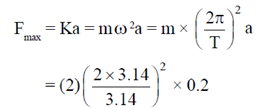
= 2 × 4 × 0.2 = 1.6 N
10. The migratory aptitude of (alkyl or aryl) substituents is Baeyer-Villiger oxidation is
(a) methyl < primary < secondary < tertiary
(b) tertiary < secondary < primary < methyl
(c) phenyl < methyl < primary < tertiary
(d) tertiary < primary < methyl < phenyl
Ans. (a)
Sol. The migratory aptitude of alkyl or aryl substituent in Baeyer-Villiger oxidation is methyl < primary < secondary < tertiary. If there is an electron with drawing group on the substituent, then it decreases the rate of migration. According to the carbocation resonance structure of Criegee intermediate, the substituent that can maintain a positive charge, would be most likely to migrate. Tertiary groups are more stable carbocations than secondary groups and secondary groups are more stable than primary. Thus the tertiary > secondary > primary > methyl trend is followed.
11. Match the entries in Group I with the entries in Group II

(a) P-(iii), Q-(ii), R-(iv), S-(i)
(b) P-(iv), Q-(iii), R-(ii), S-(i)
(c) P-(iv), Q-(i), R-(ii), S-(iii)
(d) P-(i), Q-(iii), R-(iv), S-(ii)
Ans. (b)
Sol. Epilepsy is marked by repeated seizures which are caused by uncontrolled electric discharge from nerve cells in cerebral cortex
• Alzheimer is neurodegenerative disorder marked by loss of memory i.e dementia which is caused by reduced production of acetyl choline is involved in memory and learning.
• Parkinson disease is caused by degeneration of dopaminergic neurons in substantia niagra
• Huntington disease is autosomal dominant neurodegenerative disease caused by loss of motor and cognitive function.
12. Determine the correctness or otherwise of the following Assertion (A) and Reason (R).
Assertion (A) In the process of ATP synthesis in oxidative phosphorylation, ATP synthase is not a part of electron transport chain on inner mitochondrial membrane.
Reason (R) ATP synthase is coupled to electron transport chain through proton motive force.
(a) (A) and (R) are true and (R) is the correct reason for (A)
(b) (A) and (R) are true but (R) is not the correct reason for (A)
(c) both (A) and (R) are false
(d) (A) is false but (R) is true
Ans. (a)
Sol. ATP synthesis occurs by coupling the ETC with ATP synthase. Electro transport chain (ETC) generates proton motion force (pmf) by transfer of electrons. ATP synthase then works through this pmf to generate ATP in mitochondria so we can say that ATP synthase and ETC are coupled but ATP synthase is not part of ETC
13. Higher levels of glycosylated haemoglobin (HbA1c) indicate
(a) high haemoglobin level
(b) anaemic condition
(c) diabetes
(d) favism
Ans. (c)
Sol. Diabetes is marked by increased levels of HbAlc (glycosylated hemoglobin). Under diabetic con- ditions sugar that gets accumulated becomes glycosylated by combining to hemoglobin. Higher the glucose level in blood higher will be the HbAlc value. HbAlc test is the primary test for diagnosis for diabetes
14. Match the entries in Group I with the entries in Group II

(a) P-(ii), Q-(i), R-(iii), S-(iv)
(b) P-(iv), Q-(iii), R-(ii), S-(i)
(c) P-(iv), Q-(iii), R-(ii), S-(i)
(d) P-(iii), Q-(iv), R-(i), S-(ii)
Ans. (c)
Sol. Messelson and stahl (1958) prooved that DNA replication is semiconservative
Experiments that gave evidence for origin of life on earth were initially performed by Stanley Miller and HAROLD Urey
ALFRED Harshey and Martha chase (1952) proved that are genetic material is DNA
Chemical method for RNA synthesis was given by Har Gobind Khorana.
A cell for system that could form protein without genetic code was developed by Marshal Nirenberg.
15. Match the entries in Group I with the entries in Group II
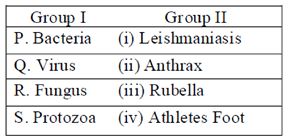
(a) P-(ii), Q-(iii), R-(iv), S-(i)
(b) P-(ii), Q-(iii), R-(i), S-(iv)
(c) P-(ii), Q-(iv), R-(iii), S-(i)
(d) P-(i), Q-(ii), R-(iv), S-(iii)
Ans. (a)
Sol. Bacillus anthracis bacterium causes Anthrax disease. Rubella virus causes Rubella viral infection. Trichophyton is a fungus causing Athlete's foot disease. Leishmaniasis is caused by a protozoan parasite Leishmania
16. In an experiment conducted in the dark, isolated chloroplasts are kept in buffer (pH 4.0) at 4°C until their internal pH is equal to 4.0. Then, they are transferred to a buffer of pH 8.0, and ADP and Pi are added at the same time. Which of the following will happen?
(a) Chloroplasts will be destroyed
(b) Chlorophyll in the chloroplast will release bound Magnesium
(c) Chloroplasts will be intact but no ATP will be produced
(d) Chloroplasts will be intact and ATP will be produced
Ans. (d)
Sol. ATP production doesn't need light but instead needs the proton gradient that will be produced by the pH difference when transferred from pH 4 to pH 8. This gradient serves as the driving force for ATP production.
17. Two mammalian cell lines with doubling times of 12 h and 36 h were cultured with radioactive thymidine for 8 h. The cells were further cultured without the Radioactivity for 72 h. Incorporated radioactivity was measured in equal number of cells in each culture, which revealed that
(a) both the cell lines had the same amount of radioactivity
(b) the fast growing cells had more radioactivity
(c) the slow growing cells had more radioactivity
(d) neither of the cells had any radioactivity
Ans. (c)
Sol. Slow growing cells show more radioactivity than fast growing cells. Radioactivity is measured by thymidine concentration which gets depleted as the cell divides. Since fast growing cells divide 6 times faster than normal cells so they show less radioactivity in comparison to slow dividing cells that replicate 2 times slow than normal cells
18. Match the entries in Group I with the entries in Group II

(a) P-(ii), Q-(i), R-(iii), S-(iv)
(b) P-(iv), Q-(iii), R-(ii), S-(i)
(c) P-(iii), Q-(iv), R-(ii), S-(i)
(d) P-(iii), Q-(iv), R-(i), S-(ii)
Ans. (b)
Sol. YEAST two hybrid system is used for detection of protein-protein intractions in vivo
• Invitro DNA -protein interaction can be identified using EMSA (electrophoretic mobility shift assay) technique
• Chromatin immunoprecipitation (ChIP) is used to identify DNA- protein interaction in-vivo . We can find desired DNA sequence binding to our known transcription factor.
• Protein structure detection can occur by NMR and x-ray Diffraction techniques NMR work by determining resolution of each atom and X-ray diffraction is detected in single crystals
19. A line L parallel to the vector  passes through the point (1, 2, 4) and meets the XY-plane at a point P. The distance between the origin and P is
passes through the point (1, 2, 4) and meets the XY-plane at a point P. The distance between the origin and P is
(a) 
(b) 
(c) 
(d) 
Ans. (d)
Sol. Equation of line passing through (1, 2, 4) and parallel to vector  is
is
 and equation of XY-plane is
and equation of XY-plane is




20. Let P(t) denote the population of species at time t. If P(t) is given by the equation  = P(1 – P) and if the initial population P(0) = 0.1 million, then the population at t = 1 is
= P(1 – P) and if the initial population P(0) = 0.1 million, then the population at t = 1 is
(a) 
(b) 
(c) 
(d) 
Ans. (a)
Sol. We have, 


log p – log (1 – p) = t + C
log  = t + C
= t + C
t = 0, p = 0.1,
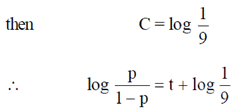



21. Let Z be the set of all integers and f and g are one-one mappings from Z into itself

(a) g(2) = 0
(b) f(3) = 2
(c) g(2) = 1
(d) f(3) = 1
Ans. (a)
Sol. We have, f(g(x)) = g(n + 1) – 1, n is even
g(f(x)) = f(n – 1) – n is odd
Put n = 2
f(g(2)) = g(3) + 1 ...(i)
n = 1
g(f(1)) = f(0) – 1 ...(ii)
g(3) = f(0) – 1
From Eq. (i) and (ii), we get
f(g(2)) = f(0) – 1 + 1
f(g(2)) = f(0)
 g(2) = 0
g(2) = 0
22. In a p-n junction, the depletion region has a width of 3 × 10–7 m and the intensity of electric field in the depletion region is 106 V/m. An electron approaches the junction from the n side with velocity v1 and enters the p side with velocity v2. If v2 = 4 × 105 m/s, then the value of v1 is
Given data Charge of electron = 1.6 × 10–19 C; Mass of electron = 9.1 × 10–31 kg
(a) 3.2 × 105m/s
(b) 4.2 × 105 m/s
(c) 5.2 × 105 m/s
(d) 6.2 × 105 m/s
Ans. (c)
Sol. Given width of depletion region, w = 3 × 10–7 m
Electric field, E = 106 v/m
v2 = 4 × 105 m/s
v1 = ?
Electric field in the depletion region is directed from n-side to p-side.
Therefore, the electron faces retarding force in moving from n-side to p-side.
Applying work-energy theorem, we get





 v1 = 5.15 × 105 = 5.2 × 105 m/s.
v1 = 5.15 × 105 = 5.2 × 105 m/s.
23. An  -particle and a proton have the same de-Broglie wavelength. Which of the following is also the same for the two particles, if they are moving at non-relativistic speeds?
-particle and a proton have the same de-Broglie wavelength. Which of the following is also the same for the two particles, if they are moving at non-relativistic speeds?
(a) Frequency
(b) Kinetic energy
(c) Momentum
(d) Speed
Ans. (c)
Sol. Let de-Broglie wavelength of  particle be
particle be  and that of proton be
and that of proton be 
It is given that, 
where, pa = momentum of alpha particle and
pp = momentum of proton.
 pp = pa
pp = pa
24. An electron is accelerated from the rest through a potential difference of 400 V. The electron, then enters a uniform magnetic field that is perpendicular to the direction of electrons. The radius of the circular path experienced by the electron is 10 cm. The angular speed of electrons, in radians/sec, is
Given data Charge of electron = 1.6 × 10–19 C; Mass of electron = 9.1 × 10–31 Kg
(a) 1.18 × 107
(b) 1.18 × 108
(c) 2.18 × 107
(d) 2.18 × 108
Ans. (b)
Sol. Given, potential difference,  = 400 V
= 400 V
Kinetic energy of the electron after accelerated through ΔV is
k = e

where, v = speed of the electron and
me = mass of the electron

where,  = angular speed of electron and
= angular speed of electron and
r = radius of circular path = 10 cm = 10 × 10–2 m

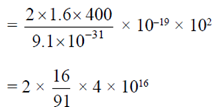

= 1.185 × 108 = 1.18 × 108 rad/sec
25. Consider two vectors P and Q of equal magnitude. If the magnitude of P + Q is two times larger than that of P – Q, then the angle between them is
(a) 107°
(b) 117°
(c) 127°
(d) 137°
Ans. (c)
Sol. Given | P | = | Q |
and | P + Q | = 2 | P – Q |
Now, (P + Q) . (P + Q) = 4 ( P – Q) . (P – Q)




26. Match the entries in Group I with the entries in Group II
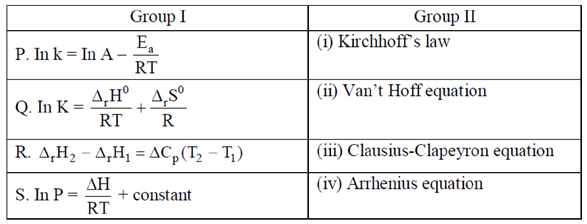
(a) P-(iv), Q-(iii), R-(i), S-(ii)
(b) P-(i), Q-(ii), R-(iii), S-(iv)
(c) P-(i), Q-(ii), R-(iv), S-(iii)
(d) P-(iv), Q-(ii), R-(i), S-(iii)
Ans. (d)
Sol. Arrhenius equation  lnk
lnk

Van't Hoff equation  lnk
lnk

Kirchhoff's law 
DrH2 – DrH1 = DCp (T2 – T1)
Clausius - Clapeyron equation 

27. The major product in the following reaction is
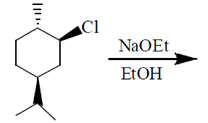
(a) 
(b) 
(c) 
(d) 
Ans. (a)
Sol.
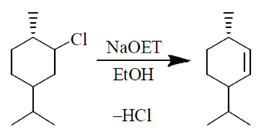
In presence of strong electron with drawing group, the reactant go for elimination.

Thus, the product will be
28. Of the given isomers of molecules I and II, the meso-form is
CH3CH(Br)CH(Cl)CH3 I CH3CH(Cl)CH(Cl)CH3 II
(a) (R, R)-isomer of I
(b) (R, S)-isomer of II
(c) (R, S)-isomer of I
(d) (S, S)-isomer of II
Ans. (b)
Sol. For a molecule to be mesoisomer, there must be an asymmetric carbon atom as well as plane of symmetry.
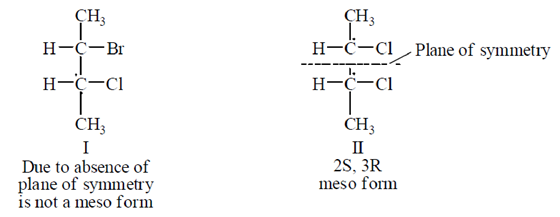
29. Considering the periodic trends of elements, which of the following is not correct?
(a) MgO and Na2O are basic, and SiO2 is acidic
(b) Atomic radius decreases in a period from left to right
(c) Order of first ionisation energies: K < Mg < Ca
(d) Order of bond energies: C – C < Si – O < N  N
N
Ans. (c)
Sol. Order of first ionisation energies will be – K > Mg > Ca.
30. Which one is the major product of the following reaction?
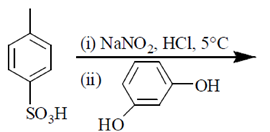
(a) 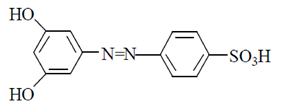
(b) 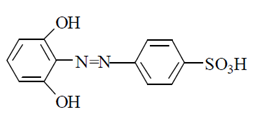
(c) 
(d) 
Ans. (c)
Sol.
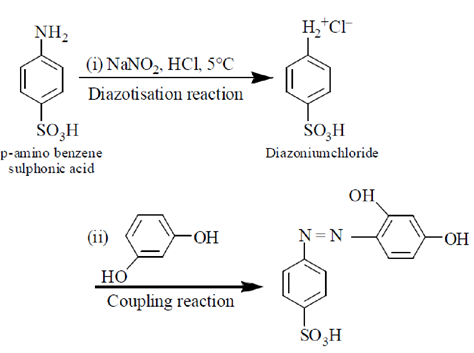
31. Identify the autoimmune disease among the following.
(a) Type II Diabetes Mellitus
(b) Type I Diabetes Mellitus
(c) Gestational Diabetes
(d) Pernicious Anaemia
Ans. (b,d)
Sol. Diabetes mellites is a type I diabetes which is also an autoimmune disorder as it destroys insulin producing  -cells of pancreas.
-cells of pancreas.
Pernicious Anaemia is caused by lack of absorption of vitamin B-12 by intestine which leads to decreased production of RBCs. It is also an autoimmune disorder as body attacks the intrinsic factor protein of cells present in lining of stomach that make it.
32. Which of the following statements are true for hydrogen bonds?
Strength of hydrogen bond is
(a) low in a solvent of high dielectric constant
(b) low in a solvent of low dielectric constant
(c) lower in water as compared to organic solvents
(d) higher in water as compared to organic solvents
Ans. (a, d)
Sol. A hydrogen bond is the electrostatic attraction between polar groups that occur when a hydrogen (H) atom binds to highly electronegative atom.
Strength of hydrogen bond is low in a solvent of higher dielectric constant and higher in water as compared to organic solvents.
33. Which of the following statements are true for cellulose?
(a) Cellulose serves a structural role
(b) Cellulose is a branched polysaccharide
(c) Cellulose is a homopolysaccharide composed of  linked D-glucose units
linked D-glucose units
(d) Cellulose is a homopolysaccharide composed of  linked D-glucose units
linked D-glucose units
Ans. (a, d)
Sol. (a, d) Cellulose is a structural hexosan (glucosan) homopolysacharide having β (1-4) glycosidic linkage forming unbranched linear chains
34. Which of the following are not true for photosynthesis?
(a) Reduction of CO2 and H2O
(b) Oxidation of CO2 and H2O
(c) Reduction of CO2 and oxidation of H2O
(d) Oxidation of CO2 and reduction of H2O
Ans. (a, b, d)
Sol. (a, b, d) Both oxidation and reduction process occurs in photosynthesis. H2O is oxidised to produced O2 and CO2 is reduced to from sugar molecule.
35. Apoptosis is a controlled process of cell death. The process involves
(a) exposure of phosphatidyl serine on the outer surface of the cell membrane
(b) decreased permeability of the outer mitochondrial membrane
(c) increased lysosomal activity
(d) inter-nucleosomal cleavage of genomic DNA
Ans. (a, d)
Sol. (a, d) Apoptosis is the programmed cell death that involves destruction of cells. Exposure of phosphatidyl serine on the outer leaflet of the membrane acts as a signal for apoptosis which is recognized by phagocytes for its clearance
36. If f(x) =  is continuous and differentiable at all points in the interval [0, 2] and f(2) =
is continuous and differentiable at all points in the interval [0, 2] and f(2) =  , 4
, 4
(a) 
(b) 
(c) 
(d) 
Ans. (a, b)
Sol. We have, f(x) = 
f(x) is continuous and differentiable at all points


a + b = c + 1



Also, f(x) is differentiable at x = 1
F'(1–) = 2a = f'(1+) = c


37. In  = 60° and S is the mid-point of QR. If QS = PS and PR = 5, then
= 60° and S is the mid-point of QR. If QS = PS and PR = 5, then
(a) 
(b) 
(c) 
(d) 
Ans. (a,d )
Sol. We have, ln  = 60°
= 60°
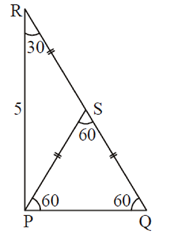
QS = SR = PS
PR = 5
ln  PQR tan 60° =
PQR tan 60° = 
PQ = PR cot 60° = 
PS = PQ = 
Area of  PSR =
PSR =  PR . RS sin 30°
PR . RS sin 30°

Now, PS = SR = QS
 S is circumcenter of
S is circumcenter of  PQR.
PQR.
38. The magnetic field in the interior of a long current carrying solenoid can be increased by
(a) increasing the length of solenoid while keeping the number of turns per unit length as constant
(b) increasing the number of turns per unit length
(c) increasing the current in the solenoid
(d) decreasing the length of solenoid while keeping the number of turns per unit length as constant
Ans. (b, c)
Sol. Strength of magnetic field produced inside the solenoid depends on:
(i) Strength of current, i.e., the magnetic field inside the solenoid can be increased by increasing the strength of the current in the solenoid.
(ii) Number of turns of wire, i.e., the magnetic field inside the solenoid can be increased by number of turns of wire in the solenoid.
39. Which of the following statements are correct?
(a) Fluorescence has a much longer decay period than that of phosphorescence
(b) Radiative transition from T1 to S0 is phosphorescence
(c) Radiative transition from S1 to S0 is fluorescence
(d) Enhancing the life time of the excited state is quenching
Ans. (b, c)
Sol. The radiative transition can occur (a) from the lowest excited singlet S1 to the ground state S0 and (b) from the lowest triplet T1 to ground singlet S0. The radiative transition between S1 S0 + hn leads to fluorescence emission and that from T1
S0 + hn leads to fluorescence emission and that from T1 S0 hν to phosphorescence emission.
S0 hν to phosphorescence emission.
40. In the 1HNMR spectrum of 1-bromopropane (structure shown below), which of the following

(a) Protons a resonate upfield to protons c
(b) Protons b reasonable downfield to protons c
(c) There are two triplets and one quartet in the spectrum
(d) Protons a appear as triplet with high chemical shift in comparison to protons c
Ans. (b, d)
Sol. Figure
C  3 H = triplet, downfield
3 H = triplet, downfield
b  Quartet, triplet upfield
Quartet, triplet upfield
a  triplet with high chemical shift
triplet with high chemical shift
41. The net charge on the following peptide at pH 7.0 is ......... .
Val-Asp-Asn-Lys-Ser-lle
Ans. (0)
Sol. To determine the net charge of amino acids at various pH values, we first need to determine the pI for each amino acid. The amino acid carries no net charge when the pH equals to pI. When pH is lower than the pI, the amino acid will carry a net positive charge. When the pH is higher than the pI, then the amino acid carries a net negative charge. In the given sequence (Val - Asp - Asn - Lys - Ser - IIe) Asp contain - 1 charge because it is an acidic amino acid. Whereas Lys is basic amino acid, so it contains +1 charge. All other amino acids are neutral at pH 7. Thus, the given peptide contains '0' net charge.
42. A 152 nm long Watson-Crick double helical DNA (B-DNA) will contain ......... turns.
Ans. (44.7)
Sol. According to HARDY weinberg equilibrium
p + q = 1
Given p (dominant allele frequency) = 0.7
So we can say q = 0.3
Also we know that
p2 + q2 + 2pq = 1
So genotypic frequency of heterozygote Aa = 2pq
= 2 × 0.7 × 0.3 = 0.42
43. A population is in Hardy-Weinberg equilibrium for a gene with only two alleles ("A" and "a"). If the gene frequency of the allele "A" is 0.7, genotype frequency of heterozygous "Aa" is ......... .
Ans. (0.42)
Sol. According to Hardy-Weinberg equation
p = frequency of dominant allele (represented by A)
q = frequency of recessive allele (represented by a)
For a population in genetic equilibrium
p+ q= 1.0
(the sum of frequencies of both alleles is 100%)
MM (p + q)2 = 1
so, p2 + 2 pq + q2 = 1
Here, p2 = frequency of AA (homozygous dominant)
2pq = frequency of Aa (heterozygous)
q2 = frequency of aa (homozygous recessive)
Given p = 0.7
 q = 1.0 – 0.7 = 0.3
q = 1.0 – 0.7 = 0.3
 The frequency of heterozygous 'Aa' is
The frequency of heterozygous 'Aa' is
2pq = 2 × 0.7 × 0.3 = 0.42
44. A receptor binds to its ligand with dissociation constant Kd = 10–8 M. The concentration of the ligand required to occupy 10% of the receptors would be 10–x M. The value of x is ......... .
Ans. (9)
Sol. [R] + [L] = [RL]
So 
where ([R] = molar concentration of receptor
[L] = molar concentration of ligand
kd = dissociation constant
As given 10% of receptor is occupied by ligand
so we can say [RL] = 0.1 [R]
kd = 10–8 = 0.1 [10–x]

x = 9
45. The plane x + y + z = 0 intersects the sphere x2 + y2 + z2 = 9 along a circle. If (2, y, z) is a point on the circle, then the value of | y + z | is ......... .
Ans. (2)
Sol. Equation of plane is x + y + z = 0
 Equation of plane is passing through origin (0, 0, 0) and centre and radius of sphere.
Equation of plane is passing through origin (0, 0, 0) and centre and radius of sphere.
x2 + y2 + z2 = 9 is (0, 0, 0) and 3, respectively.
 Centre of circle is (0, 0, 0) (2, y, z) is a point on the circle.
Centre of circle is (0, 0, 0) (2, y, z) is a point on the circle.
i.e., (2, y, z) is also lie on plane
 2 + y + z = 0
2 + y + z = 0
y + z = –2  | y + z | = 2
| y + z | = 2
46. In Young's double slit experiment, the slits are separated by a distance of 0.05 mm and the source emits light to two wavelengths 450 and 520 nm.
If the distance between the slit and viewing screen is 2 m, then the separation between 2nd order bright fringes for the two wavelengths is ......... cm.
Ans. (0.56)
Sol. In YDSE, it is given that
Slit separation, d = 0.05 mm = 0.05 × 10–3 m
Wavelengths,
 = 450 nm = 450 × 10–9 m
= 450 nm = 450 × 10–9 m
 = 520 nm = 520 × 10–9 m
= 520 nm = 520 × 10–9 m
Distance between the slit and the screen is D = 2 m
Distance of nth bright fringe from central maxima is
yn = 
 Distance of 2nd order bright fringe due to first wavelength,
Distance of 2nd order bright fringe due to first wavelength,
y21 = (2) 
Similarly, y22 = (2) 
 Separation between these 2nd order bright fringes
Separation between these 2nd order bright fringes

=  × 2(520 – 450) × 10–9
× 2(520 – 450) × 10–9
=  × 70 m = 0.8 × 7 × 10–4 × 10 m
× 70 m = 0.8 × 7 × 10–4 × 10 m
= 56 × 10–4 m = 0.56 cm
47. A jet plane lands on an aircraft carrier at 70 m/s and stops in 3 s. Assuming that the acceleration is constant, the jet plane travels a distance of ......... m before it stops.
Ans. (105)
Sol. Initial speed of jet plane
i.e., u = 70 m/s, t = 3 s, a = 3 and v = 0
 v = u + at
v = u + at
 0 = 70 + 3a
0 = 70 + 3a
 a =
a = 
Now, v2 – u2 = 2as
S = 
Distance = 105 m.
48. The number of signals is 13C NMR for the following structure is ......... .
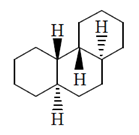
Ans. (7)
Sol. The number of signal of 13C NMR can be found out by finding the interaction of 13C with the neighbour carbon possessing hydrogens.
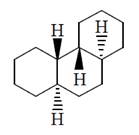
In this case, there is seven signal in 13C NMR.
49. From the database of a clinic it was found that out of 2000 patients who had visited the clinic in a year, 900 had high BP, 900 had high Sugar and 400 had neither high BP nor high Sugar. On a given day, if 20 patients visit the clinic, the expected number of patients who have both high BP and high Sugar is ......... .
Ans. (2)
Sol. Let, n(B) = number of high BP patient
n(S) = number of high sugar patient
 n(B
n(B  S) = n (B) + n(S) – n(B
S) = n (B) + n(S) – n(B  S)
S)
2000 – 400 = 900 + 900 – n(B  S)
S)
1600 = 1800 – n(B  S)
S)
n(B  S) = 1800 – 1600
S) = 1800 – 1600
n(B  S) = 200
S) = 200
In a year, number of patient who have suffered from both high BP and high sugar = 200.
 In a day =
In a day =  × 20 =
× 20 =  × 20 = 2 patient.
× 20 = 2 patient.
50. An enzyme catalyzes the conversion of 4 × 10–4 M substrate into product at a rate of 20  . If the Km value for the enzyme is 2 × 10–4 M, then the value of Vmax is .........
. If the Km value for the enzyme is 2 × 10–4 M, then the value of Vmax is ......... 
Ans. (30)
Sol. According to Michaelis Menten equation

where V is reaction velocity
Vmax is maximum velocity
[s] is substrate concentration
Km is Michaelis constant
As per the question

51. The following polypeptide chain was sequentially treated with dithiothreitol, cyanogen bromide and trypsin.
Phe-Trp-Lys-Tyr-Met-Gly-Ala-Cys-Cys-Pro-Met-Asp-Gly-Arg-Phe-Ala-Gly-Trp
The total number of fragments expected at the end of complete digestion of the polypeptide are .........
(consider that none of the reagents interfere with each other's activities)
Ans. (5)
Sol. Dithiothreitol breaks disulfide bonds of amino-acids like cysteine so we observe no cleavage of polypeptide under it's influence.
CNBr cleaves the Met residues and trypsin cleaves c terminal of arginine and lysine amino acids

So we receive 5 Fragments
52. In maize, the genes for coloured seed and round are dominant over the genes for colourles seed and shrunken seed. Pure breeding strains of the double dominant variety were crossed with the double recessive variety and a test cross of the F1 generation produced the following.

For the above, the distance between the genes for seed colour and seed shape on the chromoscomes would be ......... centimorgan units.
Ans. (3)
Sol. Total no. of off springs = 350 + 396 + 1440 = 800
Recombinant gamete frequency = 14 + 10 = 24
Rf (recombination frequency) 

53. A culture of 106 bacteria, with doubling time of 60 min, is grown in a nutrient medium at 37°C. Considering that the nutrients are unlimited, the number of bacteria at the end of 10 h would be ......... × 106.
Ans. (1024)
Sol. Logistic growth occurs under unlimited nutrient condition of medium since doubling time is 60 min so culture will have 2 × 106 cells at end of hour when initially it was 106
So, after 10 h her it will be – (2)10 × 106
2 – 4 – 8 – 16 – 32 –– 128 – 256 – 512 – 1024 × 106 cells
54. A 50-amino acid residue stretch of a globular protein adopts an extended structure containing a true  -helix of 24 residues and b-strand of 26 residues. the total length of the stretch will be ......... nm.
-helix of 24 residues and b-strand of 26 residues. the total length of the stretch will be ......... nm.
Ans. (11.4)
Sol. 2 helix contains 24 residues
1 turn of  -helix contains 3-6 residues
-helix contains 3-6 residues
No. of turns having 24 residues 
back turn of  -helix = 0.54 nm.
-helix = 0.54 nm.
6.6 turns = 6.6 × 0.54 = 3.6 nm
It is given that  -strand has 26 residues
-strand has 26 residues
But we know 1  -strand turns has 2 runiduce
-strand turns has 2 runiduce
So no. of turns having 26 residuces turns
turns
One turn of  strand = 0.6 nm
strand = 0.6 nm
Length of  -strand of 13 turns = 13 × 0.6 = 7.8 nm
-strand of 13 turns = 13 × 0.6 = 7.8 nm
Total length of stretch will be length of α-helix + length of β-strand 3.6 nm + 7.8 nm = 11.4 nm.
55. The right limit  (x – 3)2 (log (x – 3) + cosec (x – 3)2) is .........
(x – 3)2 (log (x – 3) + cosec (x – 3)2) is .........
Ans. (1)
Sol.  (x – 3)2(log(x – 3) + cosec(x – 3)2)
(x – 3)2(log(x – 3) + cosec(x – 3)2)
=  (3 + h – 3)2(log(3 + h – 3) + cosec(3 + h – 3)2)
(3 + h – 3)2(log(3 + h – 3) + cosec(3 + h – 3)2)
=  h2[log(h) + cosec2h]
h2[log(h) + cosec2h]
= 
=  (sin2 h log h + 1) = 1 × (0 + 1) = 1
(sin2 h log h + 1) = 1 × (0 + 1) = 1
56. If [x] denotes the greatest integer valued function (e.g., [1.16] = 1 and [1.8] = 1) and
 dx = L, then L = ......... degrees.
dx = L, then L = ......... degrees.
Ans. (30)
Sol. 

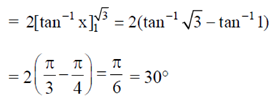
57. A copper wire having a cross-sectional area of 6.62 × 10–6 m2 carries a current 20 A. Assuming that each atom contributes one free electron to the current, the time required by electrons to travel a distance of 1 m is ......... min.
Given data Density of copper = 8.92 g/cm3, molar mass
= 63.5 g/mol and Avogadro number
= 6.02 × 1023
Ans. (74.77)
Sol. (74.77) Given, A = 6.62 × 10–6 m2, l = 1m, / = 20 A
p = 8.92 g/cm3, M. mass = 63.5 g/mol
NA = 6.02 × 1023, Density = 
 8.92 g/cm3 =
8.92 g/cm3 =  [
[  Area × Length = Volume]
Area × Length = Volume]
mass (m) = (8.92 × 6.62 × 106)g
Now, 1e– = 1 F = 1 mol of Cu = 63.5 g
 (8.92 × 6.62) g of Cu =
(8.92 × 6.62) g of Cu = = 0.9299 F
= 0.9299 F
58. A piece of charcoal, containing 36 g of carbon, found in ancient ruins shows a 14C activity of 300 decays/min. The tree, from which this charcoal came, has been dead for ......... years.
Given data The ratio of 14C to 12C is 1.3 × 10–12 in the CO2 molecules of atmosphere and the half life of 14C is 5730 yr.
Ans. (4823)
Sol. (4823) 14C activity would decrease with times. So, in order to estimate the time of death of the tree we need to find the initial activity of the sample.
We have, decay constant
= 
[ T1/2 = 5730 yr = 5730 × 3.16 × 107 s]
T1/2 = 5730 yr = 5730 × 3.16 × 107 s]
= 3.83 × 10–12 S–1
Number of 12C nuclei = Number of mole × NA
=  × 6.02 × 1023 = 1.8 × 1024
× 6.02 × 1023 = 1.8 × 1024
Since the ratio of 14C to 12C = 13 × 10–12
Therefore, number of initial 14C nuclei
N0(14C) = 1.3 × 10–12 × 1.8 × 1024 = 2.34 × 1012
Now, we can find the initial activity of sample
R0 =  × N0
× N0
= 3.83 × 10–12 × 2.34 × 1012
= 8.96 decays/sec = 538 decays/min
We've relation between present activity (R) and initial activity (R0) as


= –2.61 × 1011 × (– 0.584)
= 1.524 × 1011 sec

= 4823 years (approx).
59. AT constant pressure, 200 g of water was heated from 10°C to 22°C. The molar heat capacity of H2O at constant pressure is 75.3 JK–1 mol–1. The increase in entropy for this process is ......... JK–1.
(Consider that molar heat capacity of water is independent of temperature and that water does not expand when heated)
Ans. (34.7)
Sol. (34.7) Given, mass of water = 200 gm
CP of water = 753 jK–1 mol–1
T1 = 10° C
= (10 + 273) K
T1 = 283 K
T2 = 22° C
= (22 + 273) K
T2 = 295 K
We know that, molecular weight of water = 18 g mol–1
 Number of moles of water (n) = = 11.11111111 mol
Number of moles of water (n) = = 11.11111111 mol
Now, we have, 
= 11.11111111 mol × 75.3 JK–1 mol–1 
= 34.7 JK–1
60. The number of optically inactive geometrical isomers of [Pt(NH3)2(py)2Cl2]2+ is ......... .
(where, 'py' is pyridine)
Ans. ([Pt(NH3)2Cl2(Py)2]2+)
Sol. [Pt(NH3)2Cl2(Py)2]2+
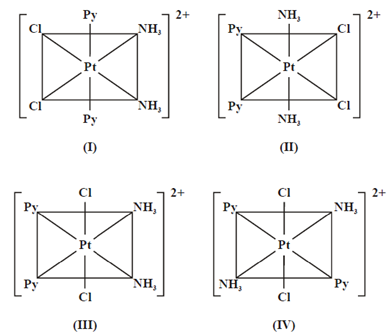
Due to presence of plane of symmetry, these four isomers are optically inactive, while fifth isomer is optically active.
